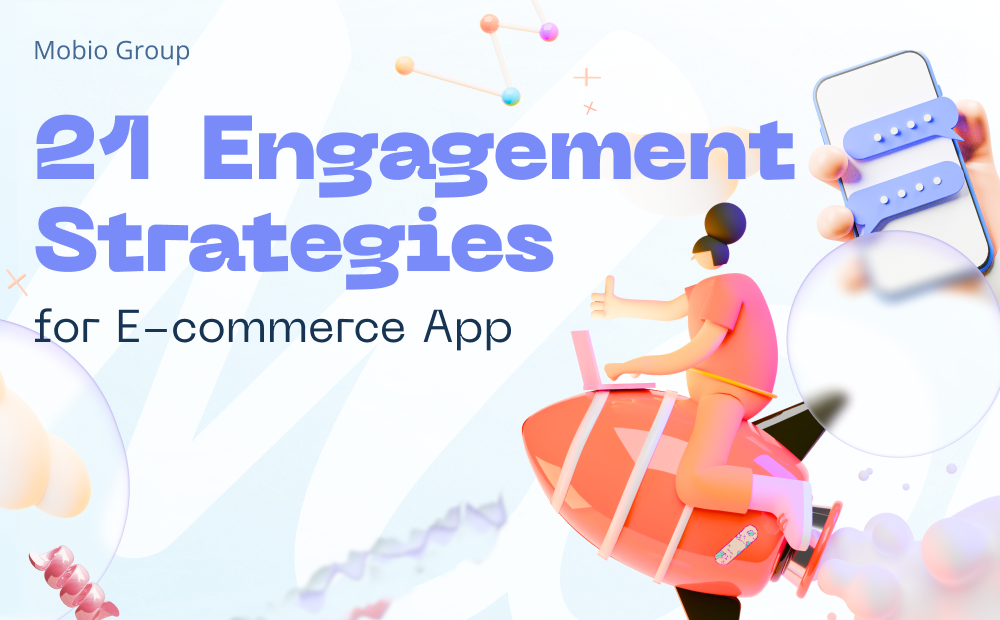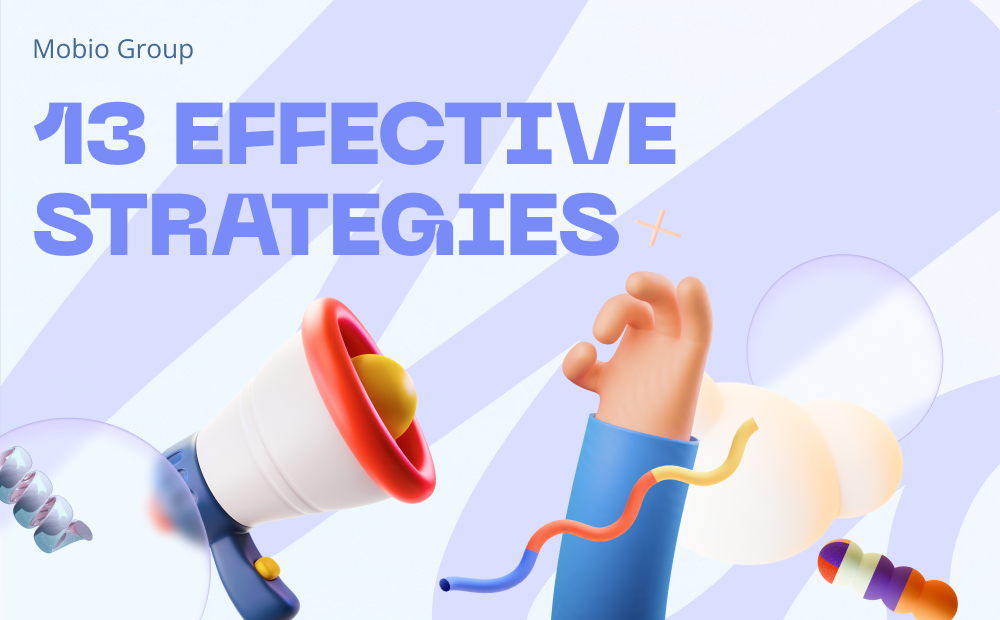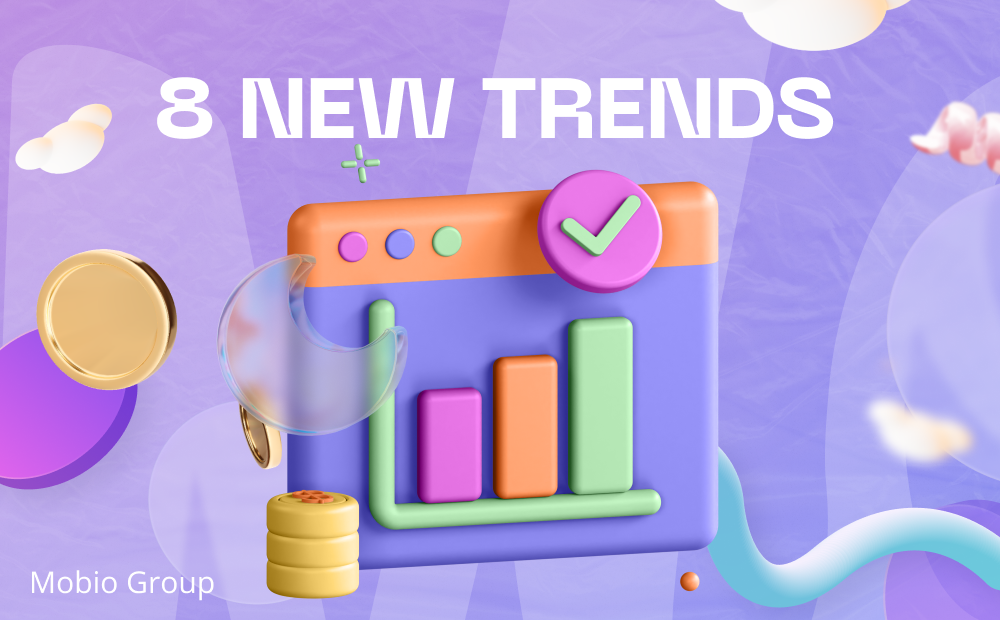E-commerce App Engagement Strategies | Mobio Group

The year 2020 saw explosive growth in e-commerce. Both the number of consumers and the number of different platforms have increased dramatically. Today, customers have a huge selection of e-commerce apps and websites and companies have to develop strategies and spend impressive budgets to attract new users. What a disappointment it is when, after all that effort and expense, the customer leaves. That’s why it pays to develop a user engagement and retention strategy as early as the app development stage. After all, it costs 5 times less to retain an existing user than it does to attract a new one. The app needs to provide a quality customer experience and stand out from the many other e-commerce apps. And in this article, Mobio Group will tell you about e-commerce app engagement strategies.
13 Standard Strategies for Increasing Engagement in the App

1. Fast Registration
Simplify the signup process by giving users a variety of easy ways to sign in: using Google and Facebook email accounts or phone numbers with a one-time password. Don’t require registration right away, let the user evaluate the assortment and prices, and offer a sign-up bonus. Seamless access to the app leads to fewer customers leaving and more sales.
2. Extended product search
The larger the online store and the more extensive the product catalog, the more attention should be paid to advanced search capabilities. This applies equally to the search bar and catalog navigation. The fewer steps a customer takes to find the product of interest, the higher the conversion rate and customer satisfaction. And positive consumer experience increases the number of repeat visits and brand loyalty.
3. Maximum information about the product
Some people think that the quality images of the product is enough, and detailed descriptions of the product no one reads, and they are not needed. But buyers are different, and if the visitor of your application wants to know more about the product and leaves to search for information on the Internet, the chances of his return for a purchase are small. In addition, detailed product descriptions reduce the likelihood of impulse purchases, and consequently customer dissatisfaction and product returns.
4. Wishlist
Wishlist is a feature that increases the number of repeat visits and increases customer loyalty. Customers like to check out items without adding them to cart, and they regularly return to their wishlists even after buying most of the items on the list.
Another benefit is that wishlist can be used as information for reminders, price reduction notifications and product recommendations to customers, which increases user engagement and sales.
5. Personalization of customer experience
A very effective tool. You provide the customer with product suggestions and recommendations based on the products they’ve previously purchased or reviewed. It makes it easier to draw the customer’s attention to discounts and offers on products that match their tastes and needs. It increases the likelihood of product purchases, increases customer engagement and loyalty, and increases the number of repeat visits to your online store. Not surprisingly, more and more sophisticated systems of personalizing recommendations are being used.
6. Fast and convenient payment
Fast and easy checkout is a very important part of e-commerce applications. It is at this stage that cart abandonment occurs most often, and everything possible should be done to minimize problems. On the one hand everything should be simple, understandable and as automated as possible, on the other hand, a wide choice of payment methods should be provided. The user should be able to pay with minimal time and effort.
7. Order management
Customers should be able to easily manage their orders via a mobile app. Being able to track shipping and returns allows the shopper to feel more in control, which in turn increases brand trust and engagement in the buying process.
8. Customer support
The customer should be able to have one-touch contact with customer support. A quick messaging feature with the support team, a live supervisor or a chat bot is a quick and effective way to show the customer that they will be taken care of in case of difficulties.
9. Offline access
The ability to view and save items when you have a poor or no internet connection and come back to buy them when network access resumes is a great way to increase sales.
10. Discounts, promotions, bonuses
Coupons and discounts have been around forever. They have successfully gone digital. Moreover, they have become much more significant than offline. The psychology of discounts is not only based on saving money.
A bargain purchase stimulates the release of oxytocin, which causes a feeling of happiness; the opportunity to buy at a discount reduces the desire to look for alternatives. Fear of missing out or “premature regret” is a powerful motivator to make a purchase.
There are a myriad of ways to give discounts: standard cash or percentage discounts, discounts with a limited validity period, threshold discounts (buy for a certain amount and get a discount), bonuses for registration, for writing a review or review, for activity in the application, thematic discount coupons for holidays or birthdays. That’s not the whole list. Most importantly, they all do a great job of engaging and retaining users in the app. You need to provide easy access to use discounts and bonuses and make sure that information about them is always in front of the customer.
11. Referral Program
A referral program is not only an easy and effective way to attract new customers, but also an effective tool for retaining existing app users. On one hand, people like advising and sharing links, and if they get bonuses for this, they like it twice as much. On the other hand, consumers are much more likely to trust recommendations from people they know. It is important that the referral program is simple, clear and profitable for users.
12. Social networks
Today social networks have billions of users. This is a place where brands can raise awareness, increase sales, create a community and actively interact with clients. But don’t get hung up on accumulating a large number of followers, quality interaction with them and engaging content is much more important. Determine the platforms your target audience spends more time on and think through user interaction strategies for each one.
Online retailers use different social media platforms for different purposes. For example, outdoor clothing brand Patagonia showcases their products and examples of their stylish combinations on Pinterest, while H&M and Zara actively use Instagram to introduce their customers to new products and fashion looks, and invite users to share their own interesting clothing combinations. Some brands’ social media serves as a customer support channel, which helps build customer trust.
13. Push Notifications
Push notifications are short, interactive messages that appear on a user’s device screen of your app, even if the app is not currently active. Surprisingly, many e-commerce app owners don’t use push notifications, but it’s a great way to keep in touch with your target audience. The main advantage of push-notifications is their maximum personalization, which provides a higher level of opening in comparison with e-mails and SMS.
Prompt notification of customers about the arrival of new products, discounts on stored goods, hot sales and promotions — not all the possibilities of push-notifications.
Let’s look at the most successful options for using push-notifications, which increase customer engagement and sales:
• Product launches and promotions
Push notifications are a great way to announce a new product launch or promotion. The speed with which information reaches the consumer is an important advantage of notifications over emails. This is especially important in the case of a time-limited promotion or, for example, a limited batch of merchandise. The letter can go unnoticed for weeks and there is a chance that the user will read it too late.
Using push notifications in conjunction with the wishlist is especially interesting — you can notify the customer about the arrival of the desired product on sale or about a price reduction on it.
• Reminder about the cart left behind
Very often users leave items in the cart without completing the purchase. This happens for different reasons: the Internet connection was interrupted, they were distracted by something more important and forgot, they couldn’t figure out the payment procedure. According to various studies, the percentage of abandoned carts in applications can be as high as 70%. With push-notifications, it’s easy to remind the user about an incomplete purchase and at the same time offer related or additional products.
• Attracting attention of inactive users
If the user hasn’t logged in to the app for a long time, you can send a notification with a reminder, offer a product he might be interested in or a nice bonus to bring him back.
• Notifications about order processing and the delivery process
When a user knows what’s going on with their order, they feel calmer and more confident, which in turn increases their trust in the app.
• An invitation to your brand’s community on social media
The only thing a customer needs to do is click on a push notification to go directly to your brand’s social media page.
• Notifications based on geotargeting
An interesting option for offline store owners. If you are close to the store, the user will receive a notification about it with an invitation to visit it. And if you add a discount coupon or other bonus to the invitation, your offer is sure to attract attention.
We’ve looked at features that are now a must-have in the e-commerce apps. But competition is growing, it’s getting harder and harder to compete for users’ attention, and retailers are constantly looking for new ways to draw customers’ attention to their apps.
We share with you a selection of new trends and interesting ways to stand out from the crowd and attract the attention of consumers.
8 New Trends and Ideas for User Engagement in E-commerce Apps

1. Voice Shopping
Voice commerce is just beginning its active development and only major brands, like Walmart, are introducing this feature and experimenting with it so far.
So what is it?
Voice shopping is the ability to shop in an app using only voice and a mobile device. The user can search for an item in the catalog, ask questions, find out ratings and reviews of products, check availability and prices, move items to the cart — all without looking at the screen of the phone or tablet or using hands. The possibilities of voice assistants based on artificial intelligence are almost limitless and depend only on the imagination of retailers. No wonder that experts consider voice shopping to be the hottest trend right now and an important step in improving the customer experience.
2. Augmented Reality
Augmented reality or AR is another strong trend in e-commerce. Shoppers like the ability to virtually try on different options before making a purchase. This helps them dispel doubts and increases confidence in their choice. Today, the most famous brand using AR is IKEA. With the help of their application you can see how the chosen piece of furniture will look in the interior of your home.
Today, augmented reality technology is being introduced by brands from various spheres of e-commerce, and they are quite successful. In the Warby Parker app, for example, you can try on glasses before you buy. Sephora in its app offers you to try out different makeup options and quickly and easily buy everything you need for the image you like. Nike Fit, an augmented reality feature in the Nike app, helps shoppers know their true shoe size just by pointing the phone camera at their feet.
3. Gamification
Engaging users through games is not a new idea. Contests and quizzes for bonuses and discounts, the wheel of fortune and the system of rewards for activity in the app have been used for a long time and consistently show good results. But sellers understand that this tool has much more potential and are experimenting with it in an attempt to find the right direction. They are approaching the issue from different angles.
A great example is Nike Winter’s Angry. In 2011, Nike launched a game in which players chose one of their outstanding athletes and helped them “beat the cold” during their winter workouts outside through various exercises. In the process, players could win various prizes, and the best players won a trip to meet one of the athletes.
But it wasn’t all just for fun. Users could buy Nike apparel worn by the athletes. In this way, the brand used the game to increase sales and awareness of the new clothing line.
4. Interactive Assistant
This tool allows you to ask a customer several questions and make recommendations based on the answers. On one hand it helps customers in choosing products, on the other hand you collect useful data which will help stimulate sales now or in the future and will be used to personalize your messages.
5. Buy Now, Pay Later
Consumers increasingly expect Buy Now Pay Later (BNPL) as an alternative way to pay for goods. Features such as Afterpay, for example, allow users to make purchases but pay later in multiple installments. This trend is gaining momentum and users are expected to use BNPLs more often than credit cards in the not-too-distant future.
6. Challenge
A very interesting strategy that hasn’t been used much yet is to create a challenge. Those who join it are more likely to share your content and more likely to be future customers of your products because they share your ideas and values.
This is how the hair care store NaturallyCurly suggested that customers participate in the “No sugar challenge” and received a significant increase in sales.
7. Using Your Smartphone Camera
A great example is the barcode scanning feature on a receipt. The user scans the barcode using the app and automatically gets bonuses or discounts in their account.
Another example is the app of the clothing store Mango. It has a built-in barcode scanner that you can use while shopping in a real Mango store.
8. Interactive Video
Interactive video with a shopping experience is an exciting combination of entertainment and e-commerce. It’s not just the end result of the purchase that gets interesting, it’s the process itself. With the help of small tags (hot spots) the customer can “navigate” through the video by choosing a route, add items to the shopping cart and complete the purchase process without stopping to watch the video.
When looking for information about a product, most people would rather watch a video than read a long article. Interactive video gives the opportunity to provide maximum information about the product, and the user does not feel like a victim of an advertising campaign, but an active participant, which causes more trust.
In addition, the sales funnel is greatly reduced, which increases the conversion rate, because for each additional step or click in the process of conversion, we lose customers.
Examples of Interactive Video Campaigns:
— BMW
BMW used an interactive video to promote the BMW 4 Series Coupe. By clicking on the tags, viewers could choose which aspects they wanted to explore more: examine the exterior of the car, visit its interior, look in the trunk and under the hood, examine the features and engineering.
— Brown Thomas
They have created master classes on beauty with the possibility of shopping. And it’s all live. From makeup tutorial videos to decorating the house for Christmas. While watching the videos, users had the ability to add items to their cart.
— Promod
Presented an interactive jeans shopping guide to customers. A style adviser demonstrated Promod jeans and explained how to choose them for different body types, and the viewers could click on the products they liked.
— Zalando
This clothing brand presented viewers with an entire mini-series, “Life of liberty,” in which they could see clothes from the new collection. Any item of clothing that appeared in the frame could be added to the cart in one click and ordered immediately.
User engagement is the basis by which you can turn a casual user who came in to see the assortment into a customer, and a one-time customer into a regular customer. It’s important to realize that user engagement and retention is a process that starts during app development and doesn’t stop until the app exists. It is necessary to constantly analyze and improve existing strategies, test new ideas and monitor the latest trends.
The Mobio Group team will be happy to help you in this difficult but fascinating process. We’ll do our best to make every person who opens your app at least once become its regular user.


